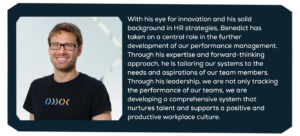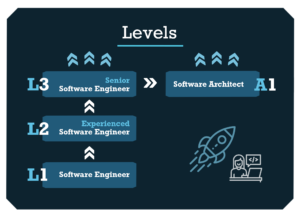
Enhancing Team Performance at NETCONOMY

The last five years have been turbulent for the IT industry, marked by rapid technological advancements and significant shifts in market dynamics. We’ve navigated the shift to remote work, the rise of AI, and significant changes in HR processes.
And all of these changes had a significant impact on how we evaluate and enhance employee productivity and engagement:
- Remote work blurred the lines of traditional office hours, making it difficult to assess performance based on presence and punctuality.
- The integration of AI demanded a new set of skills from employees, requiring continuous learning and adaptation.
- Changes in HR processes, such as the shift towards more flexible and personalized approaches, meant new metrics and strategies for performance evaluation.
As a response, performance management became a crucial topic for companies.
There’s a growing debate in HR about whether to ditch traditional performance reviews for real-time feedback. But is this the best course of action? Are traditional reviews outdated, or do they still hold value in today’s workplace?
In this blog, we answer this question by taking a close look at both approaches. Benedict, our head of human resources, will guide our conversation and share insights on NETCONOMY’s new approach to performance management – and its crucial role in employee development and organizational success.

What is Performance Management?
Performance management is a comprehensive, strategic approach to continuously improving employee performance. Consequently, it also enhances an organization’s overall productivity.
Performance management involves:
- setting clear development goals
- reviewing employees’ efforts
- providing feedback
- facilitating their development through training along predefined career paths
Benedict: “Performance management isn’t about setting goals today only to forget them tomorrow; it’s about creating a culture where every employee feels valued and driven to excel.
By engaging in performance management, companies ensure the alignment of individual objectives with the overall vision and goals. In addition, they foster a motivated, skilled, and engaged workforce.
By implementing effective performance management practices, organizations can better identify and leverage their employees’ strengths, address any areas for improvement, and drive individual and overall success.”
Benedict particularly emphasized the role of performance management in the IT industry:
“Performance management takes on a particularly critical role in the technology sector. The quick evolution of technologies (and methodologies) means that tech companies must remain on top of their product offerings and talent development strategies.
Effective performance management in tech facilitates rapid skill acquisition and adaptation, ensuring that teams are not only proficient with current technologies but also prepared for future advancements.
Furthermore, tech projects are often characterized by tight deadlines and high stakes. In this environment, clear objectives and regular feedback help align team efforts, optimize productivity, and drive innovation – making performance management necessary for sustaining competitive advantage and fostering a culture of continuous improvement.”
Traditional Performance Management vs. Continuous Feedback
Traditionally, organizations have relied on employee performance appraisals, commonly known as annual performance reviews. These formal assessments serve as a crucial benchmark for promotion and compensation decisions, evaluating relevant job competencies, achievements, and overall progress or stagnation.
In practice, employee performance appraisals often involve a comprehensive review meeting where employees and managers discuss achievements and challenges, and set goals for the upcoming period. As a result, employees clearly understand areas where they have excelled and areas where they need to improve.
However, there’s a noticeable shift in HR processes: the rise of continuous feedback. This innovative approach revolves around providing regular, real-time input and guidance to employees regarding their performance, strengths, and areas for improvement.
Unlike the traditional model – which often relies on annual or bi-annual evaluations – continuous feedback emphasizes frequent communication and collaboration between employees, their managers, and peers.
This often manifests as weekly one-on-one meetings, instant messaging for immediate praise or constructive criticism to ensure that feedback is timely and actionable.
This approach offers immediate insights and guidance, fostering a dynamic environment for growth and improvement without the constraints of scheduled review periods.
Which approach should companies opt for?
Performance Management at NETCONOMY
When Benedict started refining our performance management system, he blended elements from both traditional and modern approaches. His vision was to combine the benefits of annual performance reviews such as:
- goal setting
- identification of improvement opportunities
- providing a basis for promotions and compensation decisions
with the benefits of continuous feedback, which contributes to:
- ongoing improvement
- better employee engagement and satisfaction.
In our discussion, he gave three key reasons why he still believes in annual performance reviews:
- Annual performance reviews offer a structured framework that minimizes recency bias and ensures transparent evaluation criteria. This structured approach prevents subjective judgments and ensures fairness in evaluations.
- The reviews provide valuable insights into potential biases from various sources, including supervisors, peers, and self-assessment. By identifying and addressing biases, organizations can strive for more equitable evaluations.
- While valuable in theory, continuous feedback often lacks consistency in practice, leading to gaps in communication and development opportunities.
Benedict and his team have built a multi-stage process that combines the advantages of both methods. As in the traditional approach, our process takes place at one-year intervals.
A 360-degree feedback analysis is carried out at the beginning of the cycle year, and selective feedback analysis in the second half. This process serves as the basis for individual employee appraisals, defined development goals, and any promotions or role changes.
There is a continuous feedback loop throughout the cycle in which we adjust the targets:

Let’s have a closer look at each component.
Feedback Collection
Employees can choose up to five colleagues for their evaluation using a role-specific questionnaire. The goal is to select evaluators from varied roles and levels of seniority to capture a comprehensive and diverse assessment of one’s performance covering different areas, such as collaboration, methodological competence or self-management.
Additionally, employees conduct a self-evaluation and receive an assessment from their direct supervisor.
Calibration
In the calibration phase, our middle management comes together to establish a common understanding of what great (and not great) performance looks like and what is expected from different seniority levels within departments.
This step aims to move away from individual decisions and create alignment that promotes equality and fairness throughout the company.
To ensure this, all performance evaluations are calibrated across all department leads. If a department happens to have only one lead, the calibration happens with a relevant peer on the same level.
Appraisal
The calibrated feedback is presented to each employee during the appraisal meetings. These meetings are an opportunity for colleagues to ask questions, express concerns, and engage in discussions about their own feedback and that of their peers.
Development Goals
The outcome of the previous steps serves as the foundation for individual development goals. There, employees and their leads take a collaborative decision on where they need and want to develop. Specific courses and training support these development goals and must be undertaken before the next performance evaluation.
Continuous Feedback Loop
Development goals are closely monitored through individual sessions (One-on-One’s). During these meetings, employees receive continuous feedback on their progress, and their accomplishments are prominently recognized.
Transparency and calibrated decisions are essential in our approach to promotions and role changes. Before any transitions, the lead and the employee have a thorough discussion to clarify the new responsibilities and expectations.
Benedict: “By blending annual reviews with continuous feedback, our hybrid performance management system ensures fairness and fosters ongoing growth. Feedback must be timely and critical, not just an annual event, leading to a more resilient and adaptable organization.”
Tool Support
As part of the redesign, Benedict and his team worked to make the process as efficient as possible for everyone involved. The initial analysis revealed that some people spend too much or too little time on the review process – highlighting the need for a solution that strikes a balance by providing essential tools without overburdening any employee.
Therefore, we implemented a tool that simplifies feedback collection, categorization, and calibration while serving as a repository for one-on-one meeting notes, ensuring accessibility and continuity.
One standout feature is the instant feedback feature, empowering team members to quickly and easily acknowledge and praise one another. The flexibility to decide the visibility of feedback – whether to the individual, their supervisor, or the entire company – fosters a culture of appreciation. Moreover, it encourages connections across departments, facilitating quicker exchange of insights and building personal relationships.
Career Paths
As part of our new performance management process, our Career Paths are also being revised. These paths outline the different expectations for various roles and seniority levels at NETCONOMY.
They highlight the competencies and experiences required at different levels – crucial for fostering employee growth and retention by providing clear goals and aspirations.
Benedict: “Expecting high performance without guidance sends employees in circles. Our career paths offer a roadmap for growth, helping employees achieve their professional aspirations while contributing to the strategic goals of NETCONOMY.”
But what does this look like in practice? Let’s take a look at the career path for our software developers:

Our software developers are categorized into three levels. The titles used align with industry standards, simplifying the classification of skills and experience for outsiders.
Upon reaching level 3, known as “Senior Software Engineer,” individuals have two paths for further growth. They can choose to become a Software Architect or follow the trident model, which offers senior employees the opportunity to evolve in three distinct directions:
- management positions
- technical leadership
- individual contributor who is a specialist in an area of their interest
If a person decides on one option within the trident model, they work with their leads to create a personalized development plan that considers their unique desires, interests, and situations.
How Are People Categorized into Different Levels?
Every level has its own set of expected competencies and responsibilities, which evolve as one progresses to the next level. We distinguish between behavior and knowledge, noting that they can be developed through different methods.
Consider a technical employee who consistently champions user stories. The behavior demonstrated through the consistent execution of championing user stories can be enhanced through repeated practice and can further benefit guidance from their lead. On the other hand, the knowledge required, such as how to conduct presentations can be developed through training sessions or workshops.
We established a training catalog for our employees, enabling them to acquire or improve specific competencies at every level. Moreover, our team members can recommend additional training courses that align with their personal career goals.
Benedict: “Tomorrow is now. By equipping our team with essential competencies, we ensure all of us are prepared to tackle future challenges and drive innovation in our competitive market.”
Business Connect
The connection between business and HR is essential in designing career paths that align with our strategic goals and customer needs. By collaborating closely with the management and customer-facing departments, our HR department can identify the skills and competencies needed to achieve organizational objectives and meet client expectations.
Career paths are designed not merely as developmental tools but as strategic instruments that address critical business challenges and anticipate market demands.
This integration ensures that employees are growing personally and professionally, contributing significantly to the company’s success, and delivering exceptional value to our clients.
This alignment fosters a responsive, adaptable workforce capable of driving innovation and maintaining a competitive edge in a dynamic market.
Final Thoughts on Performance Management
As we look towards the future of performance management, we aim for flexibility, continuous growth, and an emphasis on the human element. The evolution from a stiff, once-a-year evaluation to a more flexible, continuous dialogue between employees and leaders is just the beginning.
In this upcoming era, performance management will become an integral part of every employee’s daily life, seamlessly integrating personal development with organizational goals.
Our vision at NETCONOMY is clear: to create a workspace where everyone can thrive, hitting new peaks of performance and personal satisfaction. We’re dedicated to making performance management less about ticking boxes and more about empowering every colleague to unleash their full potential.
By integrating strategies like those of the NETCONOMY Social Club and addressing the unique challenges of nurturing personal connections in a distributed workforce, we aim to build an environment where performance management is about lifting each other up and forging stronger bonds than ever before. This isn’t just about doing better; it’s about being better together.
Interested in joining our team? Explore our current job openings.
Authors and Contributors

Benedict Alfredo Theodor Stacke | Head of HR, NETCONOMY





